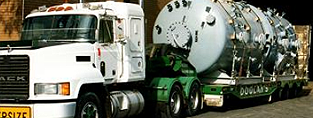
- (03) 5909 8218
- enquiry@fusionweld.com.au
Pressure and Temperature Effects in Underground Storage Tanks
January 27, 2017

Subsurface storage vessels are expected to deliver peak performance characteristics in all imaginable condition. No matter how wet, acidic, or physically oppressive the underground terrain becomes, the below ground fluid depot must securely contain its potentially hazardous load. In designing the vessels to accommodate this below ground backdrop, we need to understand how pressure and temperature variables affect underground storage tanks. What are these subterrestrial variables? More importantly, how do they impact vessel design?
Not an Equal Opportunity Locale
If the soil was composed of a pure silica base, granules that were evenly sized, then the design would be an engineering no-brainer. The uniform stuff would apply equal amounts of stress from all directions. The ground beneath our feet is rarely so obliging. Sedimentary layers and rocky outcroppings press in from one side while air pockets and cavities occupy the other end of the mounting zone. Fortunately, the varying geological conditions are accounted for by a meticulously fabricated vessel architecture, a build that adds internal ribs and reinforced weld seams to the final outlay of the tank.
Appreciating the Effects of Thermal Loads
The concrete or brick hollow acts as a stable mounting pedestal, with the walls of the pit supplementing the reinforced container. Next, temperature variances exist in the enclosed space. Warm water is removed via an installed drainage channel, but trapped heat conspires with the soil conditions to produce corrosive liquid compounds. The heat treated and post-coated tanks defeat these chemical reagents, but a soil assessment should be conducted before the underground tanks are mounted so that the acidity or alkalinity (pH) quotient can be evaluated.
The Frost Factor
A seasonal switch delivers a potent blow, and the underground containment facility experiences stress from a new direction. Frost-hardened ground contracts the soil. The ground becomes a solid block of dirty ice. Water content reverses this effect, with the ice expanding as it leaves its liquid form. In this arctic chill, low temperatures and soil conditions combine adversely to generate pressure. Desert conditions cause a similar scenario, but the event fluctuates due to the nature of the environment. Baking heat penetrates the ground pit during the day, but the desert night forces that same filled ground depression to contract.
Underground tanks are as materially robust as their surface counterparts, but they also incorporate an added elasticity factor, a series of material and architectural attributes that manages the pressure and temperature variances that dwell below ground.
Contact Details
Fusion - Weld Engineering Pty Ltd
ABN 98 068 987619
1865 Frankston Flinders Road,
Hastings, VIC 3915
Ph: (03) 5909 8218
Optimized by NetwizardSEO.com.au
Recent Posts
- Compressed Hydrogen Storage Vessels: Material Selection, Design & Australian Standards
- Welding QA/QC in Oil & Gas Pressure Vessel Fabrication – Ensuring Code Compliance
- AS1210 vs ASME VIII Pressure Vessel Code: Key Differences for Australian Projects
- Mitigating Hydrogen-Induced Cracking in Pressure Vessels: Engineering and Material Strategies
- Storage Tank Solutions Australia: Field-Erected, Prefabricated & Self-Bunded Explained
- Reducing Environmental Risks: Self-Bunded Tanks in Australian Oil & Gas Operations
- Precision in Production: How Pressure Vessels Are Manufactured for Industrial Safety
- Shell & Tube Heat Exchangers: Improve Thermal Control & Energy Recovery in Petrochemical & Pharmaceutical Plants
- In-Service Inspection for Compressed Air Receivers for Power Plant Shutdown Prevention
- Power Plant Pipe Spooling Fabrication – Get Rapid, Code-Compliant Spools Ready for Installation
- Field Erected Tanks: Safe, Reliable On-Site Fuel Storage Solutions in Australia
- Custom Pressure Vessel Fabrication for Flammable Gases
Posts 2025
- Compressed Hydrogen Storage Vessels: Material Selection, Design & Australian Standards
- Welding QA/QC in Oil & Gas Pressure Vessel Fabrication – Ensuring Code Compliance
- View all articles…
Posts 2024
- Large Process Vessels: Optimising the Design for Maximum Efficiency [2025]
- Pressure Equipment Management System Installation: Detect Equipment Faults Early
- View all articles…
Posts 2023
- Pressure Piping System Inspection: A Gift of Safety for the Holidays
- Deaerator Inspections by Fusion-Weld Engineering and How They Reduce System Downtime
- View all articles…
Posts 2022
- How Fusion Weld Keeps Up With AS-NZS ISO 9001:2008 Standard
- Boiler Equipment Safety Inspection During the Summer Season
- View all articles…
Posts 2021
- Avoid These Factors and Practices that Contribute to Sealing Damage in Pressure Vessels
- Do's And Don'ts Of Industrial Boiler Inspection And Maintenance From Fusion-Weld
- View all articles…
Posts 2020
- What are the Risks and Hazards Involved in Pressure Vessel Equipment?
- How to Know if Your Pressure Equipment Needs Repair or Replacement?
- View all articles…
Posts 2019
- Factors that Contribute to Pressure Vessel Failure
- Pressure Vessel Regulations in Australia: What are the Mandatory Requirements?
- View all articles…
Posts 2018
- Pros and Cons of Spherical vs. Cylindrical Pressure Vessels
- What are the Different Hazard Levels in Pressure Vessels?
- View all articles…
Posts 2017
- Transportable Pressure Vessels: The Importance of Inspection and Safety Checks
- Fracture Mechanics and Stress Analysis of Cracks in Pressure Vessels
- View all articles…
Posts 2016
Posts 2015
- What Are Deaerators & Feedwater Vessels?
- Precautions and Safety for Compressed Air Receiver Vessels
- View all articles…
Posts 2014
- Demonstrating In-process Inspection Procedures
- Static Grounding Practices and Standards
- View all articles…